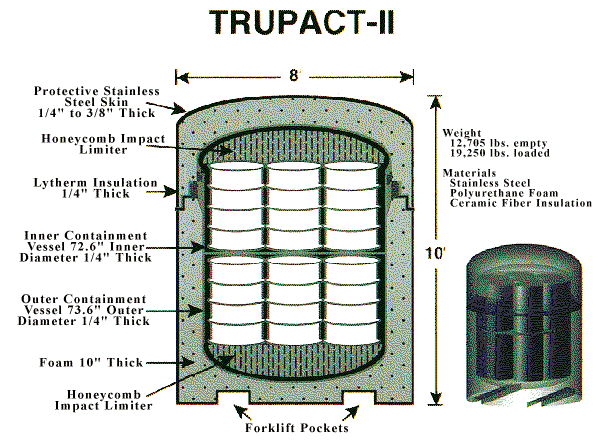
The Waste Isolation Pilot Plant is the first in its kind. It was conceived and designed to store low level radioactive wastes. Because of the many concerns the general public has about radioactive wastes being transported on freeways and through towns, WIPP has had to develop very stringent guidelines for everything it does. Among these guideslines are the requirements for maintenance of Trupac II and HalfPAC containers.
The containers have very exacting construction and weight requirements. An inner liner is honey-combed impact limiter design. Covering that is a quarter inch inner containment vessel of ceramic fiber insulation. Surrounding the inner containment vessel is another containment vessel seal of ceramic fiber insulation. All of this is surrounded by ten inches of polyurethane foam insulation. A final in Lytherm quarter of inch insulation covers this. The outside is a protective stainless steel skin from ¼ to 3/8 inches thick. Empty this container weighs 12,706 pounds. The HalfPac is similarly constructed , but it is smaller for ligther shipments. Every bit of each container must go through a rigorous 5 day inspection. If there is even the slightest problem this can be extended to as much as ten days.

The two greatest problems the containers seem to encounter are weather and road conditions. The containers travel from Washington state to Florida. They travel many of the Midwestern states and several east coast states. This provides a variety of weather conditions. Precipitation in all forms often pummels the containers. In addition, they endure heavy winds and blistering heat. Extremes in cold are encounterd in the Midwest as well.
I20 and I80 are the two primary freeways used for travel. Constant road construction and upkeep problems provide both delays and vibrations for the containers. Several detours can send the containers onto small poorly maintained roads, adding flying debris.
Our project is to take all of this into consideration and provide WIPP with a functional working schedule of maintenance. There are over 100 containers that must be kept in top shape and must be maintained on a very strict maintenance schedule. We have developed several small programs to design a visual schedule, but we have not found the best. We are continuing to work with StarLogo and will be seeking an advisor that is very adept in the program.
Team Members:
Teacher: